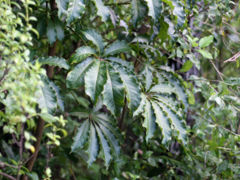Schefflera digitata: Difference between revisions
No edit summary |
No edit summary |
||
| Line 1: | Line 1: | ||
{{SPlantbox | {{SPlantbox | ||
|familia=Araliaceae | |familia=Araliaceae | ||
|genus=Schefflera | |genus=Schefflera | ||
|species=digitata | |species=digitata | ||
|common_name=Pate | |common_name=Pate | ||
| Line 25: | Line 25: | ||
|usda_ref=Flora - A Gardener's Encyclopedia | |usda_ref=Flora - A Gardener's Encyclopedia | ||
|max_zone=12 | |max_zone=12 | ||
|image= | |image=SDigitata1477.jpg | ||
|image_width=240 | |image_width=240 | ||
}} | }} | ||
'''''Schefflera digitata''''', '''Patē''' or '''Seven-finger''', is a tree endemic to [[New Zealand]] belonging to the family [[Araliaceae]]. The [[Māori language|Māori]] name is Patē or Patatē. It occurs in lowland to lower montane forests from sea level to 1200 m in the [[North Island]], [[South Island]], and [[Stewart Island]], covering a latitudinal range from 34°S to 47°S. It prefers damp, shady parts of the forest and is common along stream banks and on shady forest roadsides. It is the only New Zealand representative of the genus [[Schefflera]] which has 200 species of shrubs and small trees in the tropics and subtropics. | |||
Patē is a small, spreading tree up to 8 m high with stout branches. The leaves may have from three to nine leaflets. The leaflets are thin and soft to the touch with sharply serrated margins. In the north of the North Island, ''S. digitata'' has a juvenile stage in which the leaflets are divided into irregular toothed lobes. The inflorescence is a large, multi-branched panicle up to 35 cm across, with umbels of small greenish flowers arising at irregular intervals along its length. Each umbel contains up to ten flowers each about 7 mm in diameter. The dark violet fruits are fleshy, round, and grooved when dry. They are about 3.5 mm in diameter and take two or three months to ripen. | |||
==Cultivation== | |||
===Propagation=== | |||
===Pests and diseases=== | |||
==Varieties== | |||
==Gallery== | |||
== | <gallery perrow=5> | ||
Image:ScheffleraDigitataLeaf.jpg|The soft, thin leaves of Patē are palmate, with from three to nine leaflets | |||
Image:Upload.png| photo 2 | |||
Image:Upload.png| photo 3 | |||
</gallery> | |||
== | ==References== | ||
<references/> | |||
*[[Standard Cyclopedia of Horticulture]], by L. H. Bailey, MacMillan Co., 1963 | |||
<!--- xxxxx *Flora: The Gardener's Bible, by Sean Hogan. Global Book Publishing, 2003. ISBN 0881925381 --> | |||
<!--- xxxxx *American Horticultural Society: A-Z Encyclopedia of Garden Plants, by Christopher Brickell, Judith D. Zuk. 1996. ISBN 0789419432 --> | |||
<!--- xxxxx *Sunset National Garden Book. Sunset Books, Inc., 1997. ISBN 0376038608 --> | |||
==External links== | ==External links== | ||
*{{ | *{{wplink}} | ||
{{stub}} | |||
__NOTOC__ | |||
Latest revision as of 01:48, 21 May 2010
| Schefflera digitata subsp. var. | Pate | |||||||||||||||||||||||||||||||||||||||||||||||||||||||
|---|---|---|---|---|---|---|---|---|---|---|---|---|---|---|---|---|---|---|---|---|---|---|---|---|---|---|---|---|---|---|---|---|---|---|---|---|---|---|---|---|---|---|---|---|---|---|---|---|---|---|---|---|---|---|---|---|

|
|
| ||||||||||||||||||||||||||||||||||||||||||||||||||||||
| ||||||||||||||||||||||||||||||||||||||||||||||||||||||||
Schefflera digitata, Patē or Seven-finger, is a tree endemic to New Zealand belonging to the family Araliaceae. The Māori name is Patē or Patatē. It occurs in lowland to lower montane forests from sea level to 1200 m in the North Island, South Island, and Stewart Island, covering a latitudinal range from 34°S to 47°S. It prefers damp, shady parts of the forest and is common along stream banks and on shady forest roadsides. It is the only New Zealand representative of the genus Schefflera which has 200 species of shrubs and small trees in the tropics and subtropics.
Patē is a small, spreading tree up to 8 m high with stout branches. The leaves may have from three to nine leaflets. The leaflets are thin and soft to the touch with sharply serrated margins. In the north of the North Island, S. digitata has a juvenile stage in which the leaflets are divided into irregular toothed lobes. The inflorescence is a large, multi-branched panicle up to 35 cm across, with umbels of small greenish flowers arising at irregular intervals along its length. Each umbel contains up to ten flowers each about 7 mm in diameter. The dark violet fruits are fleshy, round, and grooved when dry. They are about 3.5 mm in diameter and take two or three months to ripen.
Cultivation
Propagation
Pests and diseases
Varieties
Gallery
-
The soft, thin leaves of Patē are palmate, with from three to nine leaflets
-
photo 2
-
photo 3
References
- Standard Cyclopedia of Horticulture, by L. H. Bailey, MacMillan Co., 1963
External links
- w:Schefflera digitata. Some of the material on this page may be from Wikipedia, under the Creative Commons license.
- Schefflera digitata QR Code (Size 50, 100, 200, 500)

